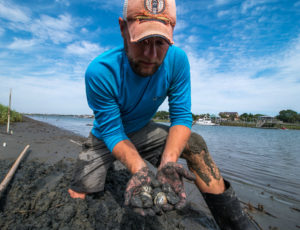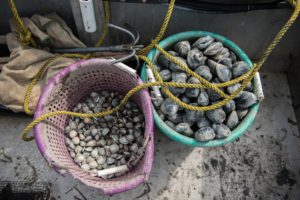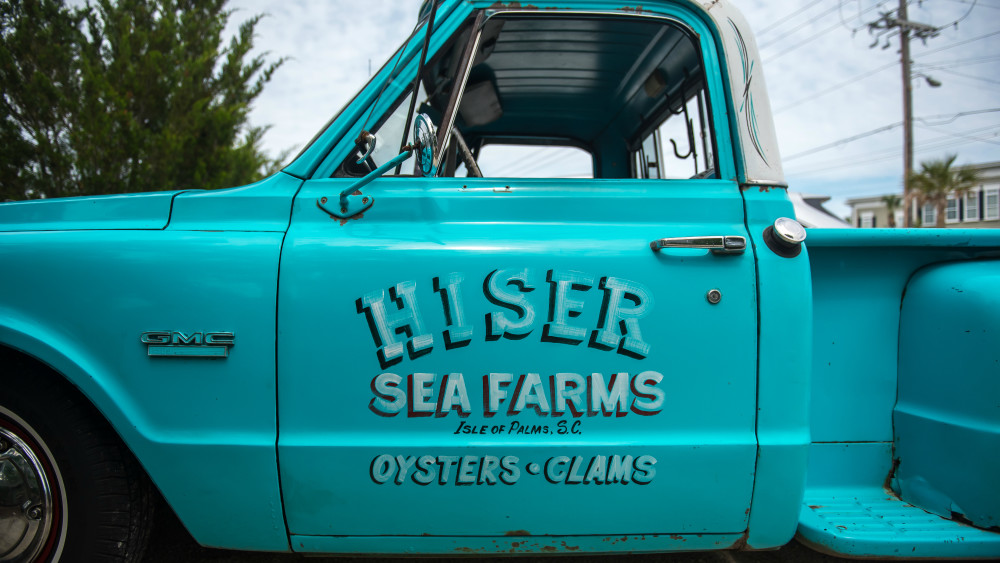Andrew and Heidi Hiser have owned and operated Hiser Sea Farms since 2013. Both born and raised on agricultural farms in central Illinois, they decided to see what life on the Carolina coast had to offer. An intriguing classified ad reading “Clam and Oyster Farm For Sale!” led the couple to Charleston to meet Toby Van Buren, owner of Tobias Seafood. A clam farmer of over 20 years, Toby was looking to retire and find the right buyer to continue his successful seafood business. We asked Andrew if he knew anything about seafood farming before relocating to Charleston and he replied, “I didn’t even know how to drive a boat!” Even still, Andrew and Heidi knew it was the perfect fit for them and set out on an exciting new adventure!

Upon moving to Charleston, Toby prepared the Hisers for success by showing them the ins and outs of clam and oyster farming and introducing them to all of his customers. They immediately felt welcomed, but knew they needed to prove themselves as local farmers. Sitting down with Andrew and Heidi, I learned more about their journey and the process of operating Hiser Sea Farm.
How are your clams raised?
We buy our clam seed from South Carolina hatcheries when they are about the size of peas. To plant the seeds, we either place them in mesh nursery bags anchored in the pluff mud or scatter them directly onto the bank, covering them with protective netting. As the water warms, the clams begin to grow and double in size after just a few months. Once they’re about the size of dimes, they’re transferred to less dense beds where they have more room to grow. At market size, the clams are ready for harvest to be sorted and bagged based on size, ranging from “pasta” to “chowder” size.
What makes Hiser Sea Farms sustainable?
Sustainability means everything to us. Our clam species is native to the East Coast, and we only sell clams that we’ve planted. Mindful of the environment, we use a cull-in-place method, knocking off small oysters and dead shell, leaving a healthy substrate on which new oysters can grow. This ensures we have product for the future, and it also protects the bank from erosion, provides wildlife habitat and promotes growth of new oyster reefs. This year, South Carolina Department of Natural Resources (SCDNR) proposed a three-inch minimum size limit on harvested wild oysters, which we already practice, and we’re excited to see how the regulation impacts the health of our oyster reefs. SCDNR also requires us to replant a certain amount of oyster shell, or cultch, per acre, which adds to the substrate on which new oysters can settle.
What’s in store for the future of Hiser Sea Farms?
We want to grow while remaining local. We love forming personal relationships with our customers and are proud that the person who hand-delivers each customer’s clams is the same person who planted, cultivated, harvested, sorted and bagged them. We’re lucky that the local demand is high enough that all of our customers are within a few miles of our dock. We’re working with other local fishermen to expand our offerings to shrimp and softshell crabs, and we’re always trying to accommodate our customers’ needs. As we continue to learn and grow, our goals is to be the community’s go-to for fresh, local, sustainable seafood!
The Hisers have done a phenomenal job of showing locals that they have what it takes to successfully farm two of the Lowcountry’s favorite seafood delights. To learn more about this local operation and order some clams or oysters for yourself, visit http://www.hiserseafarms.com/.


